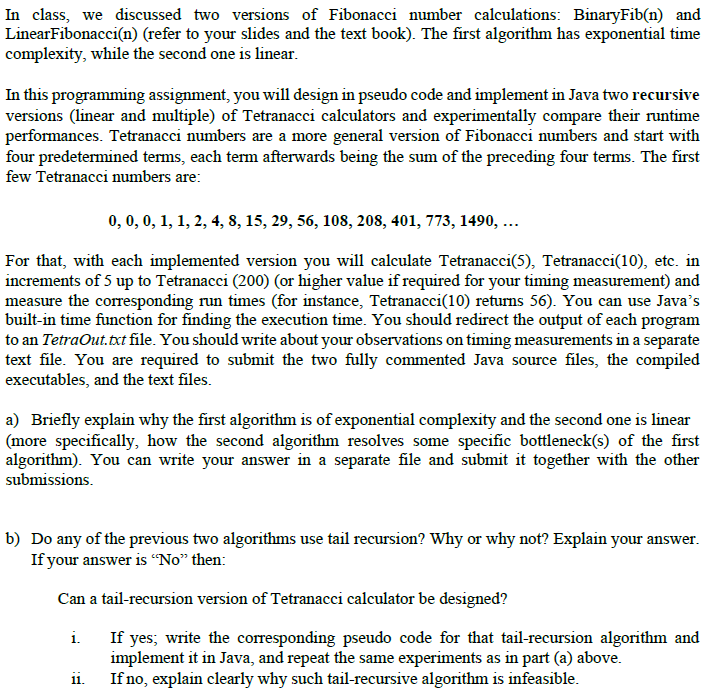Answered step by step
Verified Expert Solution
Question
1 Approved Answer
In class, we discussed two versions of Fibonacci number calculations: BinaryFib(n) and LinearFibonacci(n) (refer to your slides and the text book). The first algorithm

In class, we discussed two versions of Fibonacci number calculations: BinaryFib(n) and LinearFibonacci(n) (refer to your slides and the text book). The first algorithm has exponential time complexity, while the second one is linear. In this programming assignment, you will design in pseudo code and implement in Java two recursive versions (linear and multiple) of Tetranacci calculators and experimentally compare their runtime performances. Tetranacci numbers are a more general version of Fibonacci numbers and start with four predetermined terms, each term afterwards being the sum of the preceding four terms. The first few Tetranacci numbers are: 0, 0, 0, 1, 1, 2, 4, 8, 15, 29, 56, 108, 208, 401, 773, 1490, ... For that, with each implemented version you will calculate Tetranacci(5), Tetranacci(10), etc. in increments of 5 up to Tetranacci (200) (or higher value if required for your timing measurement) and measure the corresponding run times (for instance, Tetranacci(10) returns 56). You can use Java's built-in time function for finding the execution time. You should redirect the output of each program to an TetraOut.txt file. You should write about your observations on timing measurements in a separate text file. You are required to submit the two fully commented Java source files, the compiled executables, and the text files. a) Briefly explain why the first algorithm is of exponential complexity and the second one is linear (more specifically, how the second algorithm resolves some specific bottleneck(s) of the first algorithm). You can write your answer in a separate file and submit it together with the other submissions. b) Do any of the previous two algorithms use tail recursion? Why or why not? Explain your answer. If your answer is "No" then: Can a tail-recursion version of Tetranacci calculator be designed? i. If yes; write the corresponding pseudo code for that tail-recursion algorithm and implement it in Java, and repeat the same experiments as in part (a) above. If no, explain clearly why such tail-recursive algorithm is infeasible. 11.
Step by Step Solution
★★★★★
3.36 Rating (159 Votes )
There are 3 Steps involved in it
Step: 1

Get Instant Access to Expert-Tailored Solutions
See step-by-step solutions with expert insights and AI powered tools for academic success
Step: 2

Step: 3

Ace Your Homework with AI
Get the answers you need in no time with our AI-driven, step-by-step assistance
Get Started


